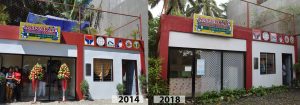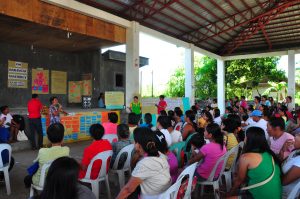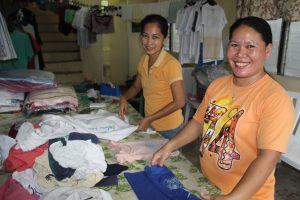When others see things as junk or garbage, some see them as gold.
Relying from what other people considered waste of the industrialized Butuan, a group named NAgkahiusang PUBring MangayKAYay (NAPUBKAY) deem these materials worth reusing, recycling – worth retrieving. What sustains their families on a daily basis are their earnings from scavenging the used bottles, plastics, and recyclable materials from the mound of rubbish piled in a certain area in Barangay Doongan. Though there is much risk in scavenging waste materials, they just seem to shrug it off, dismiss what other people say, because it is through these garbage that they live by and survive.
CDD Urban piloted
Purok 3, Doongan was the location for the city’s garbage dumpsite. While a lot of people dreaded the smell and the sight of the dumpsite and the surrounding areas, 30 families found the place as a haven – it is where they had their livelihood, their source of income. When the local city government decided to transfer the dumpsite to another location, a bigger area to address the growing industrial waste of the City, the families were devastated.

All of them cried foul. “Where will we go? We were not able to finish even elementary, we are merely only capable of doing this job, scavenging”, they said. But things had to be done. There was a need to move the dumpsite, and the one existing would be turned into a tree park, right after the official relocation.
The families were organized. They called themselves NAPUBKAY, and even though they were a bunch of scavengers, they had dreams for their group, for their families – they believed they could rise from the current status they were in, all they needed was an opportunity.
“We were told many promises of help from many agencies, but the only realized promise was that of the Department of Social Welfare and Development (DSWD),” Christopher M. Johnson shared.
Christopher was referring to the DSWD’s pilot implementation of the Kapit-Bisig Laban sa Kahirapan – Comprehensive and Integrated Delivery of Social Services’ (Kalahi-CIDSS) Urban CDD implementation. Butuan City is among the pilot areas for the new modality – Brgy. Doongan was chosen to be one of the areas for the implementation.
“A livelihood center was what we requested ever since the dumpsite was developed into an Eco-Park. We clearly articulated this during the barangay assemblies, and in the proposals that we submitted.” Christopher added.
Barangay assemblies were conducted for the program’s implementation. It was an integral part of the implementation especially that Kalahi-CIDSS utilizes the Community-Driven Development (CDD) approach. Through CDD, the people in the community are encouraged to participate and voice out their opinion, thoughts, and ideas, especially that they are the ones who will choose the project to be funded and they themselves will be actively participating in the project implementation.
It was decided by the community that a laundry shop would be perfect. DSWD, together with the Department of Labor and Employment (DOLE) and the Barangay Local Government Unit of Doongan, made sure that the proposed community project would be realized.
Now that things were in place, the implementation of the program would be an opportunity the people of Purok 3 needed to grab – and that they did. Members of the community were united, they were all excited, they all participated in the implementation of the pilot-program, even though the process was very new to them.
The project was started. One community volunteer, Lolita Daquila, served as a bookkeeper for the implementation. As she shared her experience, she recalled their experiences before it has come into fruition.
“The way the sub-project was implemented is far-different from the other government projects that I have known. In the CDD project implementation, there was a community-level consultation that happened. Even to our surprise, we were the ones who were entrusted to manage the whole implementation.” she shared.
Lolita, who does dressmaking and selling flowering plants to provide for the needs of her eight (8) children, was elated when she experienced capability building trainings through the project. She shares how her financial literacy and management trainings changed her outlook in terms of budgeting her family’s finances.
“I’m proud that I have added skills other than dressmaking and gardening, I now know how to make proposals, review Disbursement Vouchers (DVs), craft liquidation reports, and prepare procurement documents,” she enthusiastically quipped.
The Sustainable Livelihood Program (SLP), one of DSWD’s major programs provided capability trainings and seed funds for the group to ensure that they are ready to take on challenges in carrying out the sub-project. These trainings were conducted to them to facilitate and equip them in the implementation of the livelihood center.
Never a walk in the park
Lolita and Christopher’s community wasn’t excused on the presence of hindering factors as they journeyed in realizing their dream sub-project. Their group met communication gap problems, confusion of the CDD process, and some unavoidable political rivalry since the implementation process was at the peak of the barangay elections.
Little did everyone know that it even came to a point that the barangay captain decided to pull out the project in the barangay because he didn’t like the selected community volunteers and he misunderstood the CDD process. But since the Kalahi-CIDSS project strongly exercises participatory and informed decision-making, the ACT, and the Regional Project Management Office (RPMO) staff, together with the Department of Interior and Local Government (DILG), coordinated to the Barangay LGU for assembly and discussion about the issue. It was then settled after transparent communication and discussion within both parties.
Behind all and in spite and despite, finally, the efforts of the community volunteers came into realization as the laundry shop started operationalizing on June 9, 2014 which benefited the families of the NAPUBKAY association.
“We braved ourselves and our incapacities with the opportunity provided to us by the project.” expressed Christopher.
“When others only see us as lowly scavengers, the CDD approach of Kalahi-CIDSS reflects us as leaders and facilitators of change and development in our community. We initiated and worked hard. Thus, we can say, yes, KAYA NAMIN ANG PAGBABAGO!” summed Christopher.
NAPUBKAY: The early years
It was an overwhelming experience for the members of NAPUBKAY to finally enjoy the hard-earned fruits of their hard work. Through their unity, they defied the odds, they became victorious amidst the challenges they faced in achieving their community sub-project.
One of the important components of the project’s implementation is the formation of an Operation and Maintenance (O&M) Committee. The group would serve as the principal in ensuring the sub-project would serve its purpose and keep it operation, ensuring sustainability.
DSWD’s SLP continued to provide capability building trainings for the group in the early part of their operation. Apart from the provision of the lot for the laundry station building, also looked after the operation, providing any assistance the group needed. This convergence effort ensured that the laundry business was kept afloat.

Through the efforts of SLP, they were able to come up with a partnership. Go Hotel, one of the recognized hotels in Butuan was tapped as partner. Go Hotel agreed to have NAPUBKAY as their service provider. It was a great thing for the group. Business was booming. There were also loyal walk-in customers who would tap their services.
But being a newbie to the laundry business industry, they faced a lot of challenges. People were frustrated especially during moments when they were unfamiliar of the things that need to be done. Financial management became a challenge to them. Operational costs became a problem, two years into the operation. Washing machines and driers needed upgrades and fixing, and they began to realize that they are not prepared for the expenses that would eventually catch up with them as ware and tare became a problem with their machines. People began to lose interest on the livelihood they had – worse, losing interest on the association.
They began missing targets – their services became late. Their quality of service was affected. By late 2016, they lost their biggest client, Go Hotel; the biggest client that kept their business afloat. Patrons looked for other laundry stations because they could not meet agreed time in finishing their work.
The reality started to sink in. The rollercoaster ride, which was an exciting descent, now became a spiral way down.
Romela Cabellon (Barangay Social Welfare Aide), one of the Bids and Awards Committee member during the project’s implementation, recalls, “Those who used to be in-charge of operating the laundry shop gave up. They were facing a lot of problems, especially when the machines started to have a lot of problems. The income generated became lesser and lesser as months went by”.
But there were those who would not give up. It was an opportunity they could never put to waste.
Analiza Cemina, one of the members of NAPUBKAY could not accept the impending demise of their association. Together with other members of the group who still believed that the laundry station could still be saved.
“This was a big investment. We could not waste the different resources put in to start this livelihood program. We could never have an opportunity such as this, ever again,” Cemina said.
BLGU to the rescue
Romela Cabellon recalled that emotional day when members of NAPUBKAY officially set a meeting with the Barangay Chair and the council in the 4th quarter of 2016. “There were tears, there were a lot of plea. Members of NAPUBKAY reminded the BLGU of their role in sustaining the laundry station,” she said.
After the intense meeting, the BLGU and NAPUBKAY came into an agreement. Since the laundy station was losing some income due to operational expenses, the BLGU will be the one to shoulder the electricity and water expenses of the shop, until NAPUBKAY will be able to recover from the deficit they had with their finances. This was a good thing for the association, and with this, they had to be more aggressive in their operations.
NAPUBKAY: A regenerated Phoenix
The phoenix is a mythical creature, a bird, which is capable of regeneration or rebirth. NAPUBKAY, though well on its way of dying out, losing its worth, doomed to a natural death, had its rebirth when the BLGU extended a lifeline for them. This time, they can learn from their past and ensure that they sustain the livelihood they have long dreamed of.

“We had our chances. Some already left because they thought it was the end for us. But here we are with our second chance. We could no longer waste this opportunity. We need to make sure we operate our station well since our families are dependent on this business,” Cemina said.
2018 is a new year with a lot of opportunities for NAPUBKAY. In October of 2017, they were already capable of paying for the water service. Only the electric services is being shouldered by the BLGU now. Their income has also increased when some of their patrons now tap them for their services. Mary Jane Lambuyog, one of the workers in the station said that they had to step up on their marketing strategies just to ensure that people would avail of their services.
“We had to convince people to tap our services again. We even had to visit households, offices, just to convince them to have us as laundry service providers. Most importantly, we had to finish laundry jobs prior to the agreed time so that they will continue to have their laundries here in the shop,” Lambuyog said.
When people put their minds and heart on to something, there is a big chance that they will be able to achieve great things, no matter the challenges. Kalahi-CIDSS was just a tool in providing NAPUBKAY the necessary boost for them to achieve their needs. It was up to the community, to the association to realize these dreams.
With the will to provide a better life to their families, members of the NAPUBKAY Association looked for ways to ensure to rise above the challenges that hinder them from prospering. DSWD Kalahi-CIDSS, together with the different partner-stakeholders, will continue to provide opportunities to communities just like Doongan, and associations such as NAPUBKAY, to make sure that individuals, families, and communities will rise above the current situations that they are in right now, and pave the way for growth and development.
###(MARKO DAVEY D. REYES/EUNICE M. PLAZA/Kalahi-CIDSS/Social Marketing Unit/DSWD Field Office Caraga)

